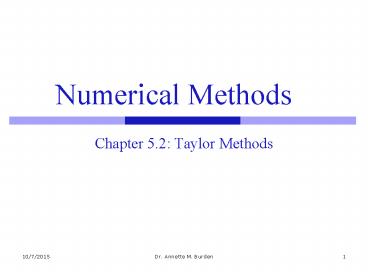Numerical Methods - PowerPoint PPT Presentation
1 / 14
Title:
Numerical Methods
Description:
Numerical Methods Chapter 5.2: Taylor Methods Introduction Differential equations - used to model problems involving a change of some variable with respect to another. – PowerPoint PPT presentation
Number of Views:74
Avg rating:3.0/5.0
Title: Numerical Methods
1
Numerical Methods
- Chapter 5.2 Taylor Methods
2
Introduction
- Differential equations - used to model problems
involving a change of some variable with respect
to another. - Problems require solution to an initial-value
problem (i.e. Diff Eq that satisfies a given
initial condition) - Diff Eq often too complicated to solve exactly,
so 1 of 2 approaches taken to approximate
solutions - Simplify the differential equation to one that
can be solved exactly and use solution of
simplified equation to approximate the original - Find methods for directly approximating the
solution of the original problem. (common
approach) - More accurate results
- Realistic error information can be obtained
3
Introduction
- Methods considered in this chapter do not produce
continuous approximations to solution of the
initial-value problem. - Approximations found at certain specified (often
equally spaced) points. - Some method of interpolation (often Hermite) used
if intermediate values are required.
4
Introduction
- Begin by considering approximation of solution
y(t) to problem of form dy/dt f(t,y), for a lt
t lt b subject to initial condition y(a) a - Later, extend the methods to a system of
first-order differential equations in the form - dy1 /dt f1(t, y1, y2,, yn)
- dy2 /dt f2(t, y1, y2,, yn)
- dyn /dt fn(t, y1, y2,, yn)
- For a lt t lt b subject to initial conditions
- y1(a) a1, y2(a) a2 , ... , yn(a)
an
5
Introduction
- Also examine relationship of a system of the type
described on the previous slide to the general
nth-order initial value problem of the form - y(n) f(t, y, y, y,, y (n-1) )
- For a lt t lt b subject to the multiple initial
conditions - y(a) a0, y(a) a1 , ... , y (n-1)
(a) an-1 - Well-Posed Condition Suppose that f and fy ,
its first partial derivative with respect to y,
are continuous for t in a,b and for all y. Then
the initial-value problem - y f(t,y), for a lt t lt b with y(a) a, has
a unique solution y(t) for a lt t lt b, and the
problem is well-posed
6
Taylor Methods - Motivation
- Function we need to expand in a Taylor polynomial
is the unknown solution to the problem y(t). - In its most elementary form this leads to Eulers
Method - Seldom used in practice
- Simplicity of derivation illustrative of
technique used for more advanced procedures
7
Eulers Method -objective
8
Eulers Method -objective
9
Eulers Method
10
Eulers Method - Example
11
Eulers Method Error Bound
12
Eulers Method Error Bound Example
13
Taylors Method of order n
14
Taylors Method of order n































